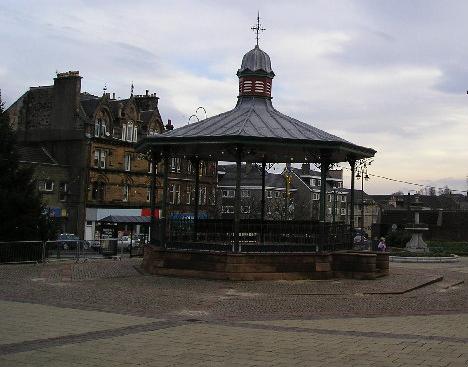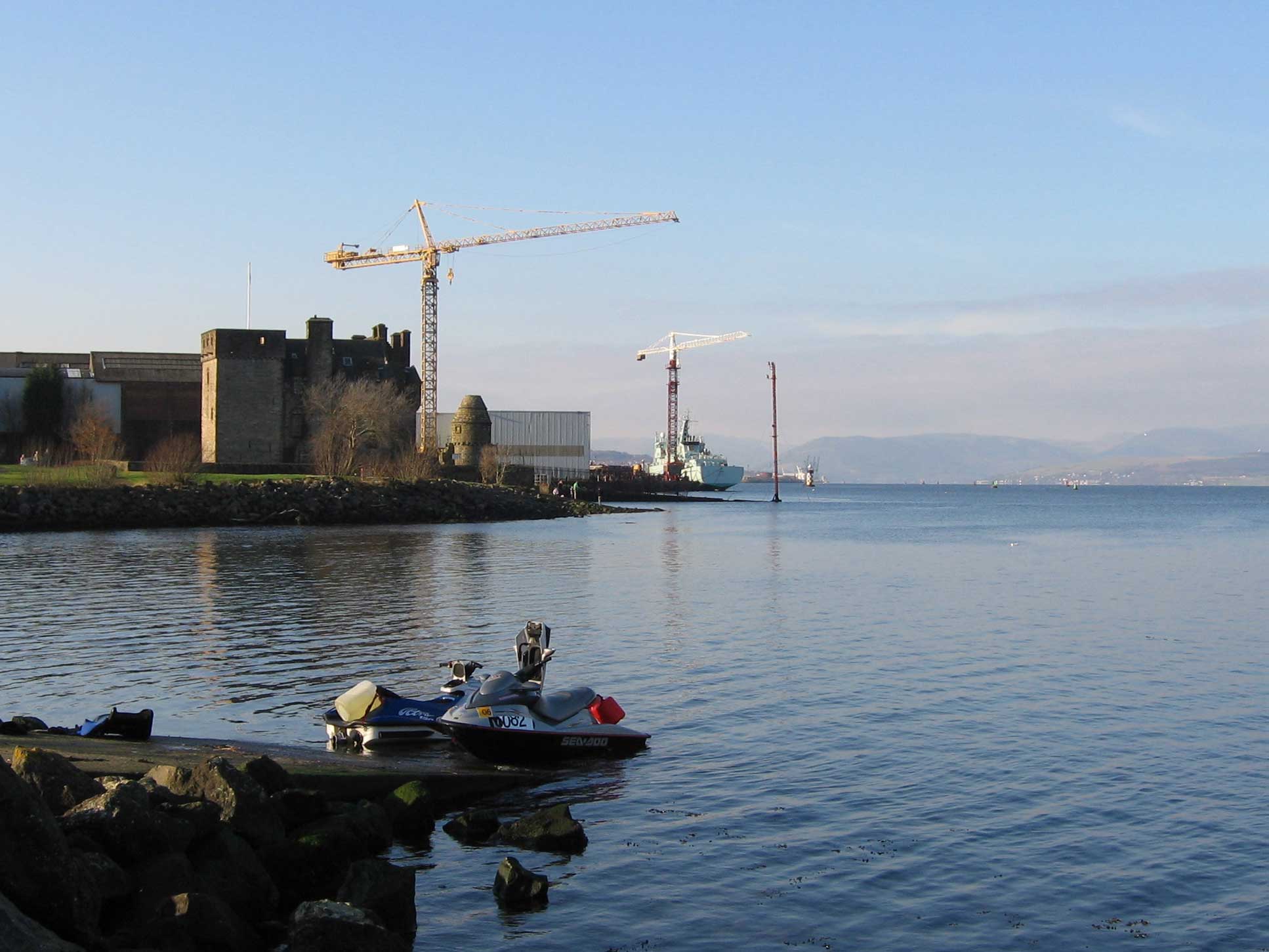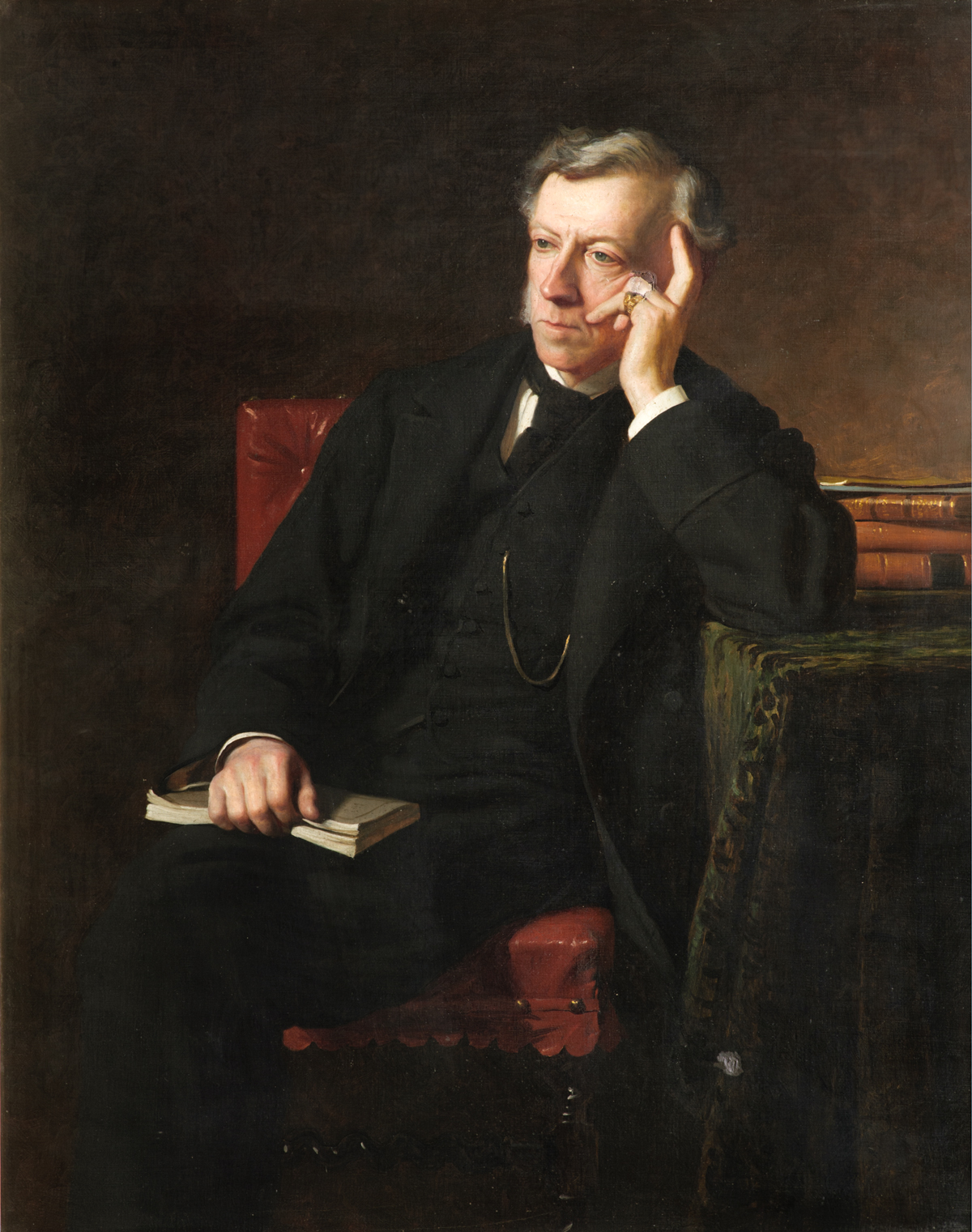|
Andrew Galbraith
Andrew Galbraith (1799–1885) was a 19th-century Scottish businessman who served as Lord Provost of Glasgow from 1857 to 1860. Life He was born in Campbeltown on 6 February 1799. Together with his younger brother Archibald Galbraith they ran A & A Galbraith, cotton spinners in Glasgow. The business had offices at 4 Bothwell Street and factories on Garngad Road. Later he also had mills at Oakbank near Glasgow. His mills employed 1200 persons. He joined Glasgow town council in the 1840s and served as Dean of Guild from 1848 to 1850. He was elected Lord Provost of Glasgow in 1857. At this time he lived at 153 St Georges Road in Glasgow. He retired to Johnstone Castle in Renfrewshire. He died at the castle on 29 November 1885 and was buried with his wife and daughters in the Glasgow Necropolis. Family He was married to Margaret Bogle Scott (1807-1850) from Port Glasgow. Artistic recognition He was portrayed in old age by Norman Macbeth Norman Macbeth (Greenock 1821 ... [...More Info...] [...Related Items...] OR: [Wikipedia] [Google] [Baidu] |
Glasgow
Glasgow ( ; sco, Glesca or ; gd, Glaschu ) is the most populous city in Scotland and the fourth-most populous city in the United Kingdom, as well as being the 27th largest city by population in Europe. In 2020, it had an estimated population of 635,640. Straddling the border between historic Lanarkshire and Renfrewshire, the city now forms the Glasgow City Council area, one of the 32 council areas of Scotland, and is governed by Glasgow City Council. It is situated on the River Clyde in the country's West Central Lowlands. Glasgow has the largest economy in Scotland and the third-highest GDP per capita of any city in the UK. Glasgow's major cultural institutions – the Burrell Collection, Kelvingrove Art Gallery and Museum, the Royal Conservatoire of Scotland, the Royal Scottish National Orchestra, Scottish Ballet and Scottish Opera – enjoy international reputations. The city was the European Capital of Culture in 1990 and is notable for its architecture, cult ... [...More Info...] [...Related Items...] OR: [Wikipedia] [Google] [Baidu] |
Johnstone Castle - Geograph
Johnstone ( sco, Johnstoun, gd, Baile Iain) is a town in the of and larger historic county of the same name, in the west of |
Campbeltown
Campbeltown (; gd, Ceann Loch Chille Chiarain or ) is a town and former royal burgh in Argyll and Bute, Scotland. It lies by Campbeltown Loch on the Kintyre peninsula. Campbeltown became an important centre for Scotch whisky, and a busy fishing port. The 2018 population estimate was 4,600 indicating a reduction since the 2011 census. History Originally known as Kinlochkilkerran (an anglicization of the Gaelic, which means 'head of the loch by the kirk of Ciarán'), Campbeltown was renamed in the 17th century as ''Campbell's Town'' after Archibald Campbell ( Earl of Argyle) was granted the site in 1667. Campbeltown Town Hall was completed in 1760. Whisky Campbeltown is one of five areas in Scotland categorised as a distinct malt whisky producing region, and is home to the Campbeltown single malts. At one point it had over 30 distilleries and proclaimed itself "the whisky capital of the world". However, a focus on quantity rather than quality, and the combination of Prohibiti ... [...More Info...] [...Related Items...] OR: [Wikipedia] [Google] [Baidu] |
Dean Of Guild
A Dean of Guild, under Scots law, was one of a group of burgh magistrates who, in later years, had the care of buildings. The leader of the group was known as Lord Dean of Guild. Originally, the post was held by the head of the Guild brethren of Scottish towns, and dates back to the 12th century. Later, the phrase ''Dean of Guild'' also described the courts A court is any person or institution, often as a government institution, with the authority to adjudicate legal disputes between parties and carry out the administration of justice in civil, criminal, and administrative matters in accorda ... set up in the 14th century to settle trade disputes. In the 19th century they became responsible for enforcing the burgh's building regulations, a role that was replaced in the mid 20th century by statutory legislation. This should not be confused with the Dean of a guild, the head of such association. References External linksThe Court of Deans of Guild of Scotland websit ... [...More Info...] [...Related Items...] OR: [Wikipedia] [Google] [Baidu] |
Johnstone Castle
Johnstone Castle ( sco, Johnstoun Castle) is a structure and former mansion in the town of Johnstone in Renfrewshire, Scotland. It belonged to the Houstons of Milliken, who acquired the estate of Easter Cochrane in 1773. The original structure was substantially enlarged in 1771 and 1812 by George Houston, who had the structure remodelled in a castellated style complete with a turret at the left hand of the front elevation, possibly by the architect James Gillespie Graham. The most notable features were barrel vaulted rooms in the ground floor. Externally in addition to the battlemented decoration there was a rope-styled string course. Although the castle and policies were considered particularly picturesque, the continued growth of the town of Johnstone reduced its size and the estate had largely disappeared by the start of the 20th century. Much of the house was demolished in 1950, and most of the remainder of the grounds was purchased by the local authority for housing in 1956. ... [...More Info...] [...Related Items...] OR: [Wikipedia] [Google] [Baidu] |
Renfrewshire
Renfrewshire () ( sco, Renfrewshire; gd, Siorrachd Rinn Friù) is one of the 32 council areas of Scotland. Located in the west central Lowlands, it is one of three council areas contained within the boundaries of the historic county of Renfrewshire, the others being East Renfrewshire to the east and Inverclyde to the west. It also shares borders with Glasgow, North Ayrshire and West Dunbartonshire, and lies on the southern bank of the River Clyde. The term Renfrewshire may also be used to refer to the historic county, also known as the County of Renfrew or Greater Renfrewshire, with origins in the 16th century. The larger Renfrewshire, containing Renfrewshire, Inverclyde and East Renfrewshire, remains in use as a registration county and lieutenancy area as well as a joint valuation board area for electoral registration and local tax valuation purposes. The town of Paisley is the area's main settlement and centre of local government and contains the historic county town, ... [...More Info...] [...Related Items...] OR: [Wikipedia] [Google] [Baidu] |
Glasgow Necropolis
The Glasgow Necropolis is a Victorian cemetery in Glasgow, Scotland. It is on a low but very prominent hill to the east of Glasgow Cathedral (St. Mungo's Cathedral). Fifty thousand individuals have been buried here. Typical for the period, only a small percentage are named on monuments and not every grave has a stone. Approximately 3,500 monuments exist here. Background Following the creation of Père Lachaise Cemetery in Paris a wave of pressure began for cemeteries in Britain. This required a change in the law to allow burial for profit. Previously the parish church held responsibility for burying the dead but there was a growing need for an alternative. Glasgow was one of the first to join this campaign, having a growing population, with fewer and fewer attending church. Led by Lord Provost James Ewing of Strathleven, the planning of the cemetery was started by the Merchants' House of Glasgow in 1831, in anticipation of a change in the law. The Cemeteries Act was passed in 18 ... [...More Info...] [...Related Items...] OR: [Wikipedia] [Google] [Baidu] |
Port Glasgow
Port Glasgow ( gd, Port Ghlaschu, ) is the second-largest town in the Inverclyde council area of Scotland. The population according to the 1991 census for Port Glasgow was 19,426 persons and in the 2001 census was 16,617 persons. The most recent census in 2011 states that the population has declined to 15,414. It is located immediately to the east of Greenock and was previously a burgh in the county of Renfrewshire. Originally a fishing hamlet named Newark, Port Glasgow came about as a result of large ships being unable to navigate the shallow and meandering River Clyde to the centre of the city of Glasgow. As a result, it was formed as a remote port for Glasgow in 1668, and became known as 'New Port Glasgow', which was shortened to 'Port Glasgow' in 1775. Port Glasgow was home to dry docks and shipbuilding beginning in 1780. The town grew from the central area of the present town and thus many of the town's historic buildings and people are found here. Port Glasgow expanded up ... [...More Info...] [...Related Items...] OR: [Wikipedia] [Google] [Baidu] |
Norman Macbeth
Norman Macbeth (Greenock 1821 – 27 February 1888 London) was a Scottish portraitist. Life He was born at Greenock, where his father James Macbeth was an excise official. He served a seven years' apprenticeship as an engraver in Glasgow, and then went to London, where he studied at the Royal Academy Schools, and copied artworks in the National Gallery. He moved on to Paris, where he worked in the Louvre and studied under a master. In 1845 Macbeth established himself as a portrait-painter in Greenock, moving to Glasgow in 1848, and in 1856 again practising in Greenock. Since 1845 he had been a regular contributor to the exhibitions of the Royal Scottish Academy, and in 1861 he went to Edinburgh. There he was successful as a portrait-painter, and was elected an Associate Royal Scottish Academician (ARSA) in 1870, and full member in 1880, entitling him to add the letters 'RSA' after his name. About two years before his death Macbeth moved to London. There he represented t ... [...More Info...] [...Related Items...] OR: [Wikipedia] [Google] [Baidu] |
1799 Births
Events January–June * January 9 – British Prime Minister William Pitt the Younger introduces an income tax of two shillings to the pound, to raise funds for Great Britain's war effort in the French Revolutionary Wars. * January 17 – Maltese patriot Dun Mikiel Xerri, along with a number of other patriots, is executed. * January 21 – The Parthenopean Republic is established in Naples by French General Jean Étienne Championnet; King Ferdinand I of the Two Sicilies flees. * February 9 – Quasi-War: In the single-ship action of USS ''Constellation'' vs ''L'Insurgente'' in the Caribbean, the American ship is the victor. * February 28 – French Revolutionary Wars: Action of 28 February 1799 – British Royal Navy frigate HMS ''Sybille'' defeats the French frigate ''Forte'', off the mouth of the Hooghly River in the Bay of Bengal, but both captains are killed. * March 1 – Federalist James Ross becomes President pro tempore of the United States Senate. * ... [...More Info...] [...Related Items...] OR: [Wikipedia] [Google] [Baidu] |
1885 Deaths
Events January–March * January 3– 4 – Sino-French War – Battle of Núi Bop: French troops under General Oscar de Négrier defeat a numerically superior Qing Chinese force, in northern Vietnam. * January 4 – The first successful appendectomy is performed by Dr. William W. Grant, on Mary Gartside. * January 17 – Mahdist War in Sudan – Battle of Abu Klea: British troops defeat Mahdist forces. * January 20 – American inventor LaMarcus Adna Thompson patents a roller coaster. * January 24 – Irish rebels damage Westminster Hall and the Tower of London with dynamite. * January 26 – Mahdist War in Sudan: Troops loyal to Mahdi Muhammad Ahmad conquer Khartoum; British commander Charles George Gordon is killed. * February 5 – King Leopold II of Belgium establishes the Congo Free State, as a personal possession. * February 9 – The first Japanese arrive in Hawaii. * February 16 – Charles Dow publishes ... [...More Info...] [...Related Items...] OR: [Wikipedia] [Google] [Baidu] |


.jpg)




